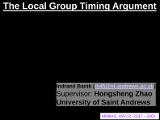Files in this item
Anomalous motions in the Local Group : evidence of a past Milky Way–Andromeda flyby?
Item metadata
| dc.contributor.author | Banik, Indranil | |
| dc.contributor.author | Zhao, Hongsheng | |
| dc.date.accessioned | 2016-09-16T15:30:12Z | |
| dc.date.available | 2016-09-16T15:30:12Z | |
| dc.date.issued | 2016-05-26 | |
| dc.identifier | 245889983 | |
| dc.identifier | 6ac6382a-aa2b-405a-84c0-83ef7697227b | |
| dc.identifier.citation | Banik , I & Zhao , H 2016 , ' Anomalous motions in the Local Group : evidence of a past Milky Way–Andromeda flyby? ' , Paper presented at American Astronomical Society Division on Dynamical Astronomy 47th Meeting , Nashville , United States , 22/05/16 - 26/05/16 . | en |
| dc.identifier.citation | conference | en |
| dc.identifier.other | ORCID: /0000-0002-4123-7325/work/29616905 | |
| dc.identifier.uri | https://hdl.handle.net/10023/9517 | |
| dc.description.abstract | The expansion of the Universe is not homogeneous. In the Local Group (LG), Andromeda (M31) is approaching the Milky Way (MW) at ~110 km/s. To turn around the cosmic expansion locally to this extent, their combined mass must lie in a narrow range of values. This constrains the gravitational field in the LG. I will describe recent calculations (arXiv:1506.07569) solving test particle trajectories in this gravitational field. The major perturber to the LG, Centaurus A, is directly included in our model. Final radial velocities (RVs) are compared with observed RVs of LG dwarf galaxies. We find a major discrepancy for all plausible initial MW and M31 masses. Although few objects have RVs much below the predictions of the best-fitting model, some have RVs much above them, by as much as 110 km/s. We find that these galaxies tend to lie within a plane. This plane aligns closely with the planes of satellite galaxies recently discovered around M31 and the MW. We suggest that the observations can be explained by a past flyby encounter between these galaxies. This doesn't arise in LCDM but does in MOND. In this context, a simple calculation suggests that their planes of satellites can be formed tidally with their observed orientations only if the MW and M31 orbit within a particular plane. Our analysis of much more distant non-satellite galaxies with anomalously high RVs implies they prefer a very similar plane. The flyby time implied by the positions and velocities of these galaxies (∼9 Gyr ago) roughly agrees with the time expected from a MOND calculation of the MW–M31 orbit. Interestingly, the velocity dispersion of the MW's disk increased suddenly at around this time, forming its thick disk. | |
| dc.format.extent | 3113170 | |
| dc.language.iso | eng | |
| dc.subject | Local group | en |
| dc.subject | Cosmology : dark matter | en |
| dc.subject | QB Astronomy | en |
| dc.subject | QC Physics | en |
| dc.subject | Astronomy and Astrophysics | en |
| dc.subject.lcc | QB | en |
| dc.subject.lcc | QC | en |
| dc.title | Anomalous motions in the Local Group : evidence of a past Milky Way–Andromeda flyby? | en |
| dc.type | Conference paper | en |
| dc.contributor.institution | University of St Andrews. School of Physics and Astronomy | en |
| dc.description.status | Peer reviewed | en |
| dc.identifier.url | http://adsabs.harvard.edu/abs/2016DDA....4730202B | en |
This item appears in the following Collection(s)
Items in the St Andrews Research Repository are protected by copyright, with all rights reserved, unless otherwise indicated.

